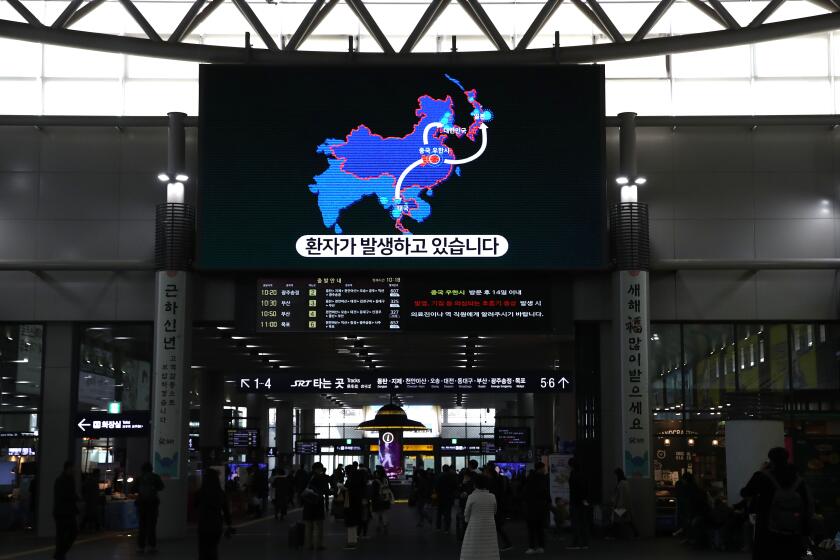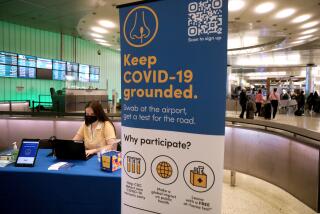Five hospitalized as coronavirus quarantine begins in San Diego

- Share via
SAN DIEGO — Shortly after touching down in San Diego, four of 167 passengers on a quarantine flight that landed Wednesday morning at Marine Corps Air Station Miramar were transported to local hospitals after showing symptoms of coronavirus infection, the U.S. Centers for Disease Control and Prevention said in a statement Wednesday night.
By Thursday evening, a fifth person had been hospitalized.
None of the American citizens or their family members aboard the airliner, who were evacuated from Wuhan, China, and its surrounding provinces, showed any symptoms when they boarded the flight.
However, medical screenings performed after their arrival at Miramar on Wednesday morning found that four adults and one child had fever or a cough, possible symptoms of infection with the novel virus that has now sickened more than 31,000 people worldwide and killed more than 630 in China.
There is no proof yet that any of the five has coronavirus. Many illnesses, including the common cold, can cause the symptoms the repatriated travelers showed. Additional DNA-based testing at the CDC will be necessary to determine what is causing those symptoms. In the meantime, all five were taken to medical facilities: Three to a UC San Diego Health hospital, and an adult and a child were sent to Rady Children’s Hospital near Kearny Mesa, the CDC said.
Dr. Francesca Torriani, medical director of infection prevention and clinical epidemiology at UC San Diego, said Wednesday afternoon, just hours before she was notified that two patients were headed her way, that care would be handled under special protocols specified by the CDC. They include isolation in “negative pressure” rooms with special equipment that keeps the air inside from entering the rest of the hospital.
If the coronavirus outbreak in China were a Hollywood movie, now would be time to panic. But in real life, most Americans have no need, experts say.
Because the virus travels for up to six feet inside large water droplets made airborne when an infected person coughs or sneezes, all medical personnel will wear gowns, gloves, face masks or goggles and custom-fitted N95 masks to cover their mouths and noses when they enter patients’ rooms.
Overall, she said, caring for a patient with coronavirus is similar to caring for a patient with the flu, which spreads in the same way. These kinds of precautions, she said, are common, especially with patients who have conditions such as tuberculosis, and their use requires no additional training.
“This is what we do normally,” Torriani said. “We have patients in contact precautions for other reasons very often and so hospital personnel [are] very familiar with those rules.”
She said that potential coronavirus cases are not a severe enough threat to require the use of a special isolation ward created at UC San Diego Medical Center in Hillcrest during the Ebola outbreak of 2014. Regular negative-pressure isolation rooms available at the hospital, or Jacobs Medical Center, its sister facility in La Jolla, would be adequate to the task, and the university is not planning to say which of the two hospitals the three adults are being sent to.
The location is more clear for the child and adult because Rady Children’s operates the only pediatric medical center in the region.
Dr. Nick Holmes, chief operating officer at Rady, said Wednesday afternoon that handling such cases should be well within the capabilities of all hospital personnel. Like UC San Diego, Rady increased its infectious disease control and isolation capabilities in 2014 during the Ebola scare.
“For these cases, we’re using the regular personal protective equipment that we would use for any other airborne pathogen because its transmission is similar to influenza,” Holmes said. “We use this equipment each and every day at the hospital. It’s our normal course of business, and our staff and nurses have standard competencies in being able to do this.”
Given that Rady generally treats only children, it was not clear Wednesday night how the hospital would handle receiving an adult. An official at the hospital directed all questions to the CDC.
Earlier in the day, Dr. Christopher Braden, a deputy director with the CDC deployed to handle repatriation flights from China to California, said during a news conference that the strategy is to isolate anyone with symptoms because doing so is the best way to prevent such a virus from starting the kind of person-to-person path that can eventually result in a pandemic.
Braden met with base personnel at Miramar on Tuesday night, letting them know how the quarantine would work and that all arriving from China would be housed in two locations: the Bachelor Enlisted Quarters and the Inns of the Corps at Miramar. The quarters normally house transient military personnel, while the Inns of the Corps operates as a hotel. Both have been vacated to facilitate the quarantine, according to Capt. Matthew Gregory, a base spokesman.
A face mask won’t do much to protect you from the new coronavirus from China. If you want to reduce your risk of getting sick, focus on washing your hands.
Braden said Wednesday afternoon that some were concerned about having potential coronavirus cases in their midst, including whether it might put their children at risk. The physician noted that no base personnel are allowed to visit the two buildings under quarantine, so there should be no worries about contamination.
“We know this situation may be concerning to people in the Miramar base [and] in the surrounding community; however, based on our experience with other coronaviruses, we don’t believe these individuals pose a risk to the community because we’re doing all we can to take measures to minimize any potential exposures,” Braden said.
While waiting out their 14 days, the CDC has directed those inside the cordon to stay six feet away from each other if they’re concerned about infection, though that precaution is not considered essential because it generally takes prolonged exposure for viral transmission and anyone with preliminary symptoms would be removed to a hospital immediately.
Pains are being taken, Braden added, to make this quarantine, the first that the CDC has undertaken in 50 years, comfortable. All are to be provided with three meals per day plus snacks and on-site medical care if they need it. One of the two locations has a playground that quarantined children can use, and a second is to be installed soon.
“We hope to provide for children that they would have somewhere where they could play and grow while they’re here,” Braden said.
The number of people who arrived at Miramar on Wednesday, Braden said, was smaller than he first expected. When the flight was first envisioned, he said, it looked like it would have about 290 people on board. Chatting with some of the newly arrived travelers Wednesday, Braden said, it appeared that some who originally intended to evacuate changed their minds at the last minute.
“They thought that actually, for some people, they may have signed up to come and be evacuated but it was a very hard decision because they are leaving family behind and maybe they changed their mind,” Braden said.
CDC and military officials said Wednesday they expected Miramar to receive another flight from China this week. But Braden warned that everything about the current evacuation plan is fluid.
“This mission changes, if not by the day, then by the hour,” he said.
Miramar is one of three California military bases being used as quarantine sites — the others are Travis Air Force Base and March Air Reserve Base. Travis received another aircraft with quarantined Americans on Wednesday and March is housing 198 people who arrived Jan. 29.
Three bases outside California are also designated quarantine sites. Those are: Ft. Carson, Colo.; Lackland Air Force Base in San Antonio; and, as the Pentagon announced Wednesday, Camp Ashland, Neb.
Sisson writes for the the San Diego Union Tribune. Staff writer Andrew Dyer contributed to this report.
More to Read
Sign up for Essential California
The most important California stories and recommendations in your inbox every morning.
You may occasionally receive promotional content from the Los Angeles Times.













